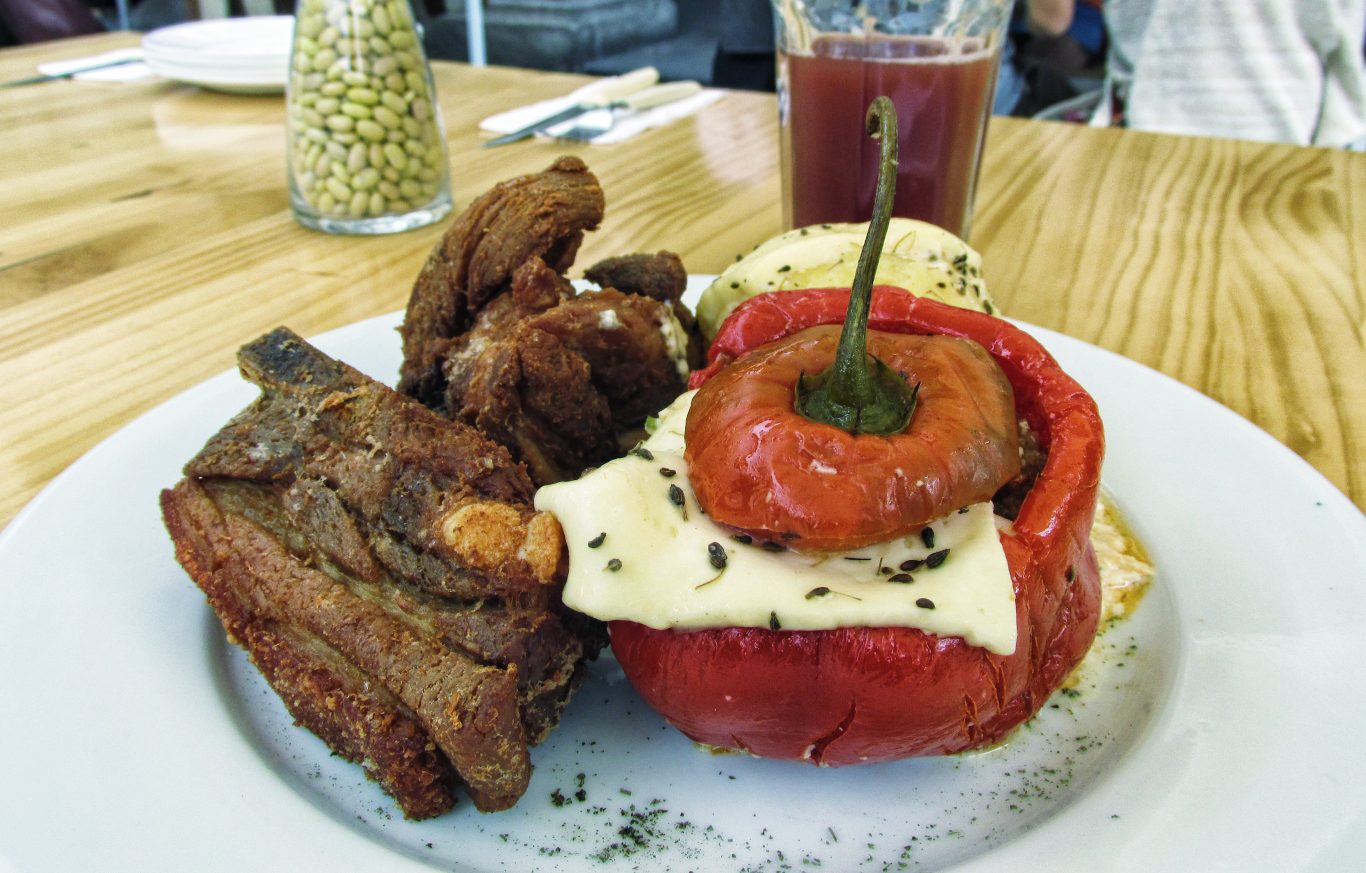
Rocoto relleno, a dish of stuffed rocoto chili pepper, can be one of the hottest dishes in Peru, depending on how much heat is removed from the pepper. Photo by Tony Dunnell.
Is Peruvian food spicy? Yes it is, if we’re talking about the use of spices in general (Peruvian food is not normally bland, although there are exceptions).
Is Peruvian food hot, as in hot-hot, Scoville hot, makes-you-cry-and-drink-milk-hot? Most definitely not, apart from a handful of dishes.
So if you don’t like spicy food, you’ll be fine in Peru as long as you avoid a few piquant plates that can bring tears to your eyes.
A Bit on the Side
Articles in travel magazines and on food websites often state that Peruvian food is hot. Respectable food websites like Eater, for example, call Peruvian food spicy, even including it on their list of the “world’s hottest cuisines.”
The Telegraph includes “papa a la hunciana” [sic] among its selection of the world’s spiciest foods, the most “fiery dishes” on the planet (it should be spelled “papa a la huancaína”).
The Food Network also includes papa a la huancaína in its own list of the world’s spiciest foods, as it supposedly contains chili peppers that are “bound to set your mouth on fire.”
And why do these respectable publications say this? They say it because they’re wrong.
Peruvian food can be hot if you add chili-based sauces and salsas to your dish. But these are almost always accompaniments, just like mayonnaise or ketchup, placed on your table to add as you see fit.
Some of these ají sauces, as they’re called, are quite potent. Rocoto sauces and salsas, and ají charapita sauces in the jungle, can have quite a kick. They’re not normally face-burningly hot (sometimes they are), but you’ll hate them if you don’t like spicy food. As a side note, the citrusy ají de cocona — which is particularly popular in Iquitos — is one of the finest sauces you’ll ever try in your life; it’s often so mild that it packs no heat at all, so give it a go even if you don’t normally like spicy-hot food.
Most Peruvian salsas like this are zesty rather than hot. But if the red bits are ají rocoto, or the yellow bits are ají charapita, watch out. Photo by Tony Dunnell.
Some Hot and Spicy Peruvian Dishes
You’ll need to avoid some Peruvian dishes if you really hate spicy food. Alternatively, you can ask beforehand if it’s hot (“¿Es picante?” or just “¿Pica?”) and then ask if the cook can make it without ají (“Sin ají, por favor”).
Classic Peruvian dishes to potentially avoid include:
- Rocoto relleno — An iconic dish from Arequipa, now sold all over Peru, rocoto relleno is made by stuffing a whole rocoto pepper. The pepper is normally boiled a couple of times in salt water to remove some of the heat, but it can still be quite fiery. It’s delicious, but best avoided if you don’t do heat.
- Ceviche — Yes, ceviche. There are various types of ceviche and not all are spicy-hot, but they do typically contain finely chopped ají chili peppers (normally ají limo, which is certainly hot enough to notice). The good news is you can always ask for your ceviche sin ají (without chili) — just don’t forget to let the waiter know when you order.
- Leche de tigre — Basically the left-over juices from ceviche, spooned out and drunk as a pick-me-up and hangover cure. I can be super spicy and eye-squintingly citrusy, enough to put hairs on your chest.
- Ají de gallina — This creamy ají amarillo-based chicken dish sometimes appears in articles about hot Peruvian food. In reality, and despite having “ají” in its name, ají de gallina is normally mild at most. But if you’re extra sensitive or happen to order an unusually hot ají de gallina, then you might not like it at all.
- Picante de [……..] — You’ll often see picante de [something] on a Peruvian menu. It could be picante de cuy, picante de langostinos, picante de mariscos (one of my favorites) etc. Most of the time, and despite the word “picante” (spicy), these dishes aren’t particularly hot — often not hot at all. But it’s worth asking before you order.
- Papa a la huancaína — OK, so The Telegraph, the Food Network, List 25, and others seem convinced that papa a la huancaína is a prime example of a hot, spicy, even fiery Peruvian dish. Well, I’ve eaten papa a la huancaína tens of times (it’s a common starter throughout Peru) and it’s never struck me as a particularly spicy dish. Yes, it contains ají amarillo, but that doesn’t make anything particularly hot (including ají de gallina) unless you really load up on the ají and maybe include some of the seeds. I know Peruvians who hate hot food and will always ask for ceviche without ají, but they happily eat papa a la huancaína. So generally speaking, it’s one to avoid only if you’re super sensitive or unless the chef says it’s hot.






Share This
Thanks for commenting! If your comment requires an answer, I'll try to reply as soon as possible. In the meantime, please share this post with your friends.